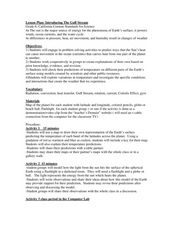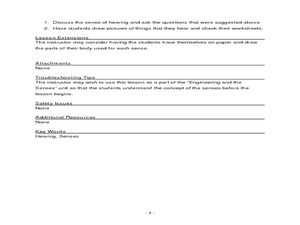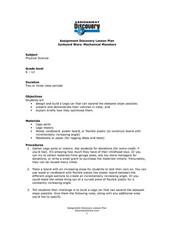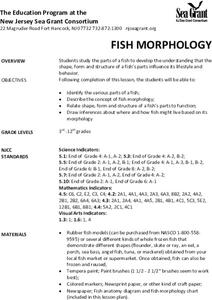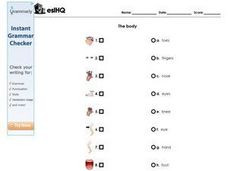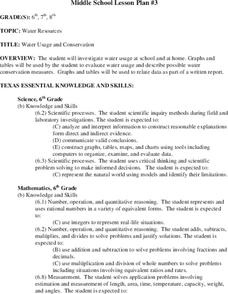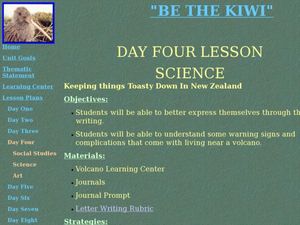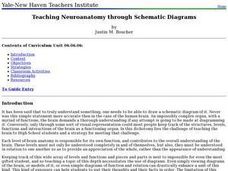Curated OER
Lesson Plan Three: Sense of Hearing and The Ear
Students use their sense of hearing to observe sounds at school, label parts of the ear, and write their own version of the "Ears Hear" poem by following the example provided.
Curated OER
What is Matter?
Learners create a definition of matter. In this physical science lesson, students work in pairs to sort items printed on cards into several categories (matter, non-matter, and unsure) and agree on a definition of matter.
Curated OER
Respiratory System
Students identify the parts of the respiratory system and how they interact. They define vocabulary words and draw an outline of themselves and label the parts of the respiratory system. They distinguish between healthy and unhealthy...
Curated OER
Exploring the Circulatory System: Getting to the Heart of It All
Seventh graders study how the heart functions and its parts. In this circulatory system lesson students learn how to take their pulse, blood pressure and respiration.
Curated OER
Systems
In this systems worksheet, students read a selection about systems in science and graphic organizer about the forest system. Finally, they answer 4 short answer questions.
Curated OER
"Da" I's Have It: A Fun Look At The Eye
Students study the human eye. In this science lesson plan, students construct 3 models of the human eye and take part in a play that highlights the parts of the eye.
Curated OER
It's My Body
Students research the human body. In this human body lesson, students brainstorm the connections between the parts of a bike and a human digestive system. Students work in small groups and research a specific body system. Students then...
Curated OER
Introducing The Gulf Stream
Sixth graders research the average temperatures of different places on Earth. In this earth science lesson plan, 6th graders explain how the sun's heat cause ocean movement. They discuss how temperature change affects the weather we...
Curated OER
Engineering and the Senses: Hearing
Students explore the sense of hearing. In this 5 senses lesson, students consider how humans and animals use the sense of hearing along with their other senses. Students discuss the body parts responsible for the 5 senses and...
Curated OER
Cell Factory
Young scholars examine the basic structures and functions of cells. They design and construct a factory cell model where each factory part corresponds to a cell part.
Curated OER
Which Household Cleaners or Soaps Work Best Against Bacteria?
Students experiment to determine the efficacy of various household cleaning products and soaps as antibacterial agents. They work in groups to complete this four part lesson series which includes identifying household bacteria,...
Curated OER
A Mini Insect Field Trip
Students practice the four skills they have already explored so far: collecting, labeling, pinning, and making field observations on insects and plants in the RHS Outdoor Science Classroom.
Curated OER
Mechanical Monsters
Young scholars experiment try to build a Lego car. In this physical science lesson students present and demonstrate the vehicle that they constructed.
Curated OER
Fish Morphology
Learners identify the various parts of a fish. They describe the concept of fish morphology and relate shape, form and structure of a fish's parts to function.
Curated OER
ESL The Body Word/Picture Matching Worksheet
In this ESL body parts worksheet, students examine 10 small pictures of body parts. They match the pictures to the words that name them such as toes, fingers, nose, and eyes.
Curated OER
Water Usage and Conservation
Students investigate water usage at school and at home. They use graphs and tables to evaluate water usage. Students describe possible water conservation measures. They use graphs and tables to relate data as part of a written report.
Curated OER
Paper Internet Scavenger Hunt
In this science learning exercise, students conduct Internet research to answer 15 questions about the history and process of papermaking. They also write an essay explaining how to make paper.
Curated OER
Shadow Trackers
Learners use online websites to inquire about the cycle of day and night. In this web based instructional activity, students are able to see the movement of the sun and Earth. Learners can look at different parts of the Earth as if they...
Curated OER
Complicated Machine
In this human body as a complicated machine learning exercise, students match descriptions of body parts with pictures. An answer key is given.
Curated OER
Keeping Things Toasty in New Zealand
Students identify the signs of a volcanic eruption. In this earth science lesson, students compose a letter to their neighbor convincing them of an impending eruption. They recognize the danger in living near a volcano.
Curated OER
Teaching Neuroanatomy through Schematic Diagrams
Students identify the parts and function of a neuron. They explain and illustrate the levels and functions of the nervous system including neurons and the Central and Peripheral Nervous Systems. They analyze and diagram the Lobes and...
Curated OER
Body Organization and Organ Systems
Eighth graders begin the lesson by building a house of cards. They discuss ways that building a house of cards is similar to the way the body is built: different systems work together to help the whole body work together. Students listen...
Curated OER
Game 3-1
In this vocabulary activity, learners answer the question, "What is it?" to identify the object in each picture. Each picture features a part of the body. The activity is intended for use with English language learners.
Curated OER
Anatomy of the Heart
Tenth graders examine the different parts of the heart. In this biology lesson, 10th graders perform dissection of the fetal pig. They explain how the heart maintains homeostasis.







